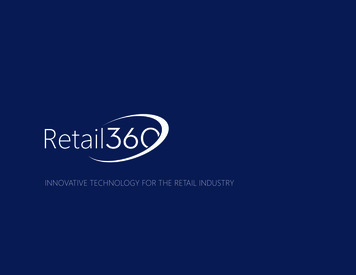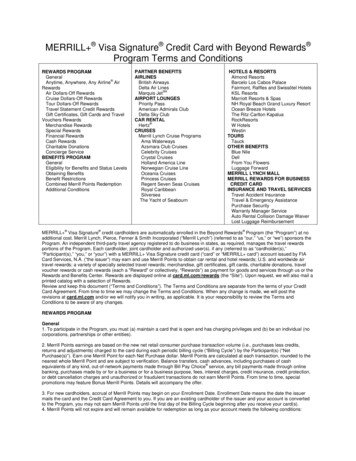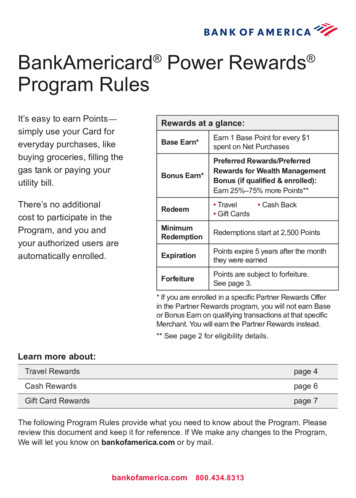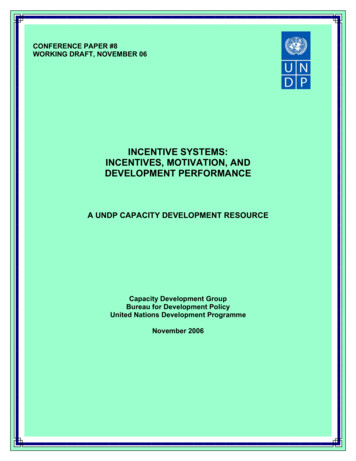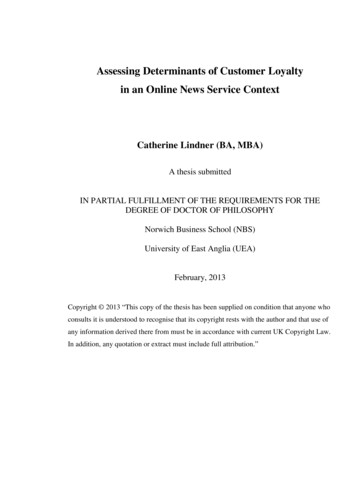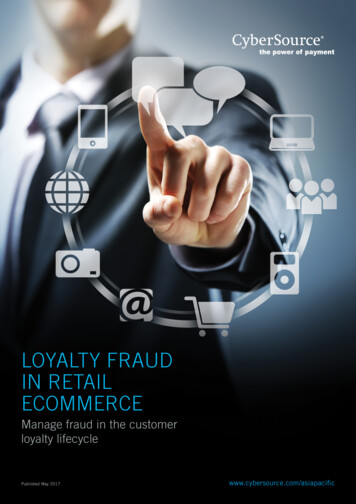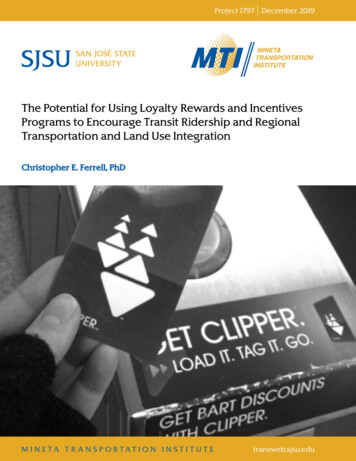
Transcription
Project 1797December 2019The Potential for Using Loyalty Rewards and IncentivesPrograms to Encourage Transit Ridership and RegionalTransportation and Land Use IntegrationChristopher E. Ferrell, PhDM I N E TA T R A N S P O RTAT I O N I N S T I T U T Etransweb.sjsu.edu
MINETA TRANSPORTATION INSTITUTELEAD UNIVERSITY OFMineta Consortium for Transportation MobilityMTI FOUNDERHon. Norman Y. MinetaMTI BOARD OF TRUSTEESFounded in 1991, the Mineta Transportation Institute (MTI), an organized research and training unit in partnership with theLucas College and Graduate School of Business at San José State University (SJSU), increases mobility for all by improving the safety,efficiency, accessibility, and convenience of our nation’s transportation system.Through research, education, workforce development,and technology transfer, we help create a connected world. MTI leads the four-university Mineta Consortium for TransportationMobility, a Tier 1 University Transportation Center funded by the U.S. Department of Transportation’s Office of the AssistantSecretary for Research and Technology (OST-R), the California Department of Transportation (Caltrans), and by private grantsand donations.MTI’s transportation policy work is centered on three primary responsibilities:ResearchMTI works to provide policy-oriented research for all levels ofgovernment and the private sector to foster the developmentof optimum surface transportation systems. Research areasinclude: bicycle and pedestrian issues; financing public and privatesector transportation improvements; intermodal connectivityand integration; safety and security of transportation systems;sustainability of transportation systems; transportation / land use /environment; and transportation planning and policy development.Certified Research Associates conduct the research. Certificationrequires an advanced degree, generally a Ph.D., a record ofacademic publications, and professional references. Researchprojects culminate in a peer-reviewed publication, available onTransWeb, the MTI website (http://transweb.sjsu.edu).EducationThe Institute supports education programs for students seeking acareer in the development and operation of surface transportationsystems. MTI, through San José State University, offers an AACSBaccredited Master of Science in Transportation Management andgraduate certificates in Transportation Management,TransportationSecurity, and High-Speed Rail Management that serve to preparethe nation’s transportation managers for the 21st century.With theactive assistance of the California Department ofTransportation(Caltrans), MTI delivers its classes over a state-of-the-artvideoconference network throughout the state of Californiaand via webcasting beyond, allowing working transportationprofessionals to pursue an advanced degree regardless of theirlocation. To meet the needs of employers seeking a diverseworkforce, MTI’s education program promotes enrollment tounder-represented groups.Information and Technology TransferMTI utilizes a diverse array of dissemination methods andmedia to ensure research results reach those responsiblefor managing change. These methods include publication,seminars, workshops, websites, social media, webinars,and other technology transfer mechanisms. Additionally,MTI promotes the availability of completed research toprofessional organizations and journals and works tointegrate the research findings into the graduate educationprogram. MTI’s extensive collection of transportation- relatedpublications is integrated into San José State University’sworld-class Martin Luther King, Jr. Library.Founder, Honorable NormanMineta (Ex-Officio)Secretary (ret.), US Department ofTransportationVice ChairHill & Knowlton, Inc.Honorary Chair, Honorable BillShuster (Ex-Officio)ChairHouse Transportation andInfrastructure CommitteeUnited States House ofRepresentativesHonorary Co-Chair, HonorablePeter DeFazio (Ex-Officio)Vice ChairHouse Transportation andInfrastructure CommitteeUnited States House ofRepresentativesChair, Grace Crunican(TE 2019)General ManagerBay Area Rapid Transit District(BART)Vice Chair, Abbas Mohaddes(TE 2018)President & COOEconolite Group Inc.Executive Director,Karen Philbrick, Ph.D.Mineta Transportation InstituteSan José State UniversityRichard Anderson (Ex-Officio)President and CEOAmtrakLaurie Berman (Ex-Officio)DirectorCalifornia Departmentof TransportationDonna DeMartino (TE 2018)General Manager and CEOSan Joaquin Regional Transit DistrictMortimer Downey* (TE 2018)PresidentMort Downey Consulting, LLCNuria Fernandez* (TE 2020)General Manager & CEOSanta Clara Valley TransportationAuthorityJohn Flaherty (TE 2020)Senior FellowSilicon Valley AmericanLeadership ForumRose Guilbault (TE 2020)Board MemberPeninsula Corridor JointPowers BoardEd Hamberger (Ex-Officio)President & CEOAssociation of American RailroadsWill Kempton (TE 2019)RetiredArt Leahy (TE 2018)CEOMetrolinkJean-Pierre Loubinoux(Ex-Officio)Director GeneralInternational Union of Railways (UIC)Paul Skoutelas (Ex-Officio)President & CEOAmerican Public TransportationAuthority (APTA)Beverley Swaim-Staley(TE 2019)PresidentUnion Station RedevelopmentCorporationLarry Willis (Ex-Officio)PresidentTransportation Trades Dept.,AFL-CIOBradley Mims (TE 2020)President & CEOConference of MinorityTransportation Officials (COMTO)Bud Wright (Ex-Officio)Executive DirectorAmerican Association of StateHighway and TransportationOfficials (AASHTO)Jeff Morales (TE 2019)Managing PrincipalInfraStrategies, LLC(TE) Term Expiration* Past Chair, Board of TrusteesDan Moshavi, Ph.D. (Ex-Officio)DeanLucas College and GraduateSchool of BusinessSan José State UniversityResearch Associates Policy Oversight CommitteeKaren Philbrick, Ph.D.Ben TripousisFrances Edwards, Ph.D.Executive DirectorNational High-Speed RailConnectivity Center DirectorPolitical ScienceSan José State UniversityJan Botha, Ph.D.Taeho Park, Ph.D.Asha Weinstein Agrawal, Ph.D.Hilary Nixon, Ph.D.The contents of this report reflect the views of the authors, who are responsible for the facts and accuracy of the information presentedherein. This document is disseminated in the interest of information exchange. The report is funded, partially or entirely, by a grant from the U.S.Department of Transportation’s University Transportation Centers Program. This report does not necessarily reflect the official views or policiesof the U.S. government, State of California, or the Mineta Transportation Institute, who assume no liability for the contents or use thereof.This report does not constitute a standard specification, design standard, or regulation.Diane Woodend Jones (TE 2019)Principal & Chair of BoardLea Elliot, Inc.Dan Smith (TE 2020)PresidentCapstone Financial Group, Inc.DirectorsEducation DirectorNational Transportation Finance CenterUrban and Regional PlanningSan José State UniversityDisclaimerSteve Heminger* (TE 2018)Executive DirectorMetropolitan TransportationCommission (MTC)Civil & Environmental EngineeringSan José State UniversityOrganization and ManagementSan José State UniversityKatherine Kao Cushing, Ph.D.Christa BaileyResearch & Technology Transfer DirectorEnviromental ScienceSan José State UniversityBrian Michael JenkinsDave Czerwinski, Ph.D.National Transportation Safety andSecurity Center DirectorMarketing and Decision ScienceSan José State UniversityMartin Luther King, Jr. LibrarySan José State University
REPORT 19-33THE POTENTIAL FOR USING LOYALTY REWARDS ANDINCENTIVES PROGRAMS TO ENCOURAGETRANSIT RIDERSHIP AND REGIONAL TRANSPORTATIONAND LAND USE INTEGRATIONChristopher E. Ferrell, PhDDecember 2019A publication ofMineta Transportation InstituteCreated by Congress in 1991College of BusinessSan José State UniversitySan José, CA 95192-0219
TECHNICAL REPORT DOCUMENTATION PAGE1. Report No.19-332. Government Accession No.3. Recipient’s Catalog No.4. Title and SubtitleThe Potential for Using Loyalty Rewards and Incentives Programs to EncourageTransit Ridership and Regional Transportation and Land Use Integration5. Report DateDecember 20197. AuthorsChristopher E. Ferrell, PhD https://orcid.org/0000-0002-3285-10088. Performing Organization ReportCA-MTI-17979. Performing Organization Name and AddressMineta Transportation InstituteCollege of BusinessSan José State UniversitySan José, CA 95192-021910. Work Unit No.12. Sponsoring Agency Name and AddressU.S. Department of TransportationOffice of the Assistant Secretary forResearch and TechnologyUniversity Transportation Centers Program1200 New Jersey Avenue, SEWashington, DC 2059013. Type of Report and Period CoveredFinal Report6. Performing Organization Code11. Contract or Grant No.69A355174712714. Sponsoring Agency Code15. Supplemental Notes16. AbstractThe initial inspiration for this research project came from the idea that transit smart cards could be used as a tool for increasingtransit ridership, retail sales in transit-oriented developments (TODs) and eventually, increasing retail development in TODs.This might work by expanding the scope and capabilities of transit smart cards to include “customer loyalty rewards” capabilities,thereby increasing patronage of retail businesses located in TODs. From this inspiration, a plan was developed to gather researchliterature on the relationships between smart cards and transit ridership, between transit ridership and retail activities, and betweenretail sales and retail development in TODs. In the process of this literature search, examples were identified of programs thathave been implemented in North American transit agencies. For three of these cases—in Montreal, Canada; in Minneapolis/St. Paul, Minnesota; and in the San Francisco Bay Area, California—case study profiles were developed from a combination ofsource publication materials, traditional and electronic media, and telephone interviews with program representatives.17. Key WordsPublic Transit; Transit Ridership;Transit-Oriented Development;Marketing; Smart Cards18. Distribution StatementNo restrictions. This document is available to the public throughThe National Technical Information Service, Springfield, VA 2216119. Security Classif. (of this report)Unclassified20. Security Classif. (of this page)UnclassifiedForm DOT F 1700.7 (8-72)21. No. of Pages7322. Price
Copyright 2018by Mineta Transportation InstituteAll rights reservedDOI: 10.31979/mti.2019.1797Mineta Transportation InstituteCollege of BusinessSan José State UniversitySan José, CA 95192-0219Tel: (408) 924-7560Fax: (408) 924-7565Email: mineta-institute@sjsu.edutransweb.sjsu.edu121019
ivACKNOWLEDGMENTSThe authors thank Editing Press, for editorial services, as well as MTI staff, includingExecutive Director Karen Philbrick, PhD; Deputy Executive Director Hilary Nixon, PhD;Graphic Designer Alverina Eka Weinardy; and Executive Administrative Assistant Jill Carter.Min e ta Tra n s p o rt a t io n I n s t it u t e
1TABLE OF CONTENTSExecutive Summary 3I. Introduction4II. Literature Review5Setting the Stage: Linking Smart Cards, Ridership, and Transit-OrientedDevelopment-Based Retail 5The Effectiveness of Transit and Retail Rewards Programs 8III. Transit Rewards Programs in Practice19Montreal, Quebec: Société De Transport De Montréal’s STM Merci! Program 19Minneapolis/St. Paul, Minnesota: Metro Transit’s Ride to Rewards Program 26San Francisco Bay Area: BART Perks Program 30Other Notable Transit Ridership Rewards Programs 35IV. Conclusions and Implications for Future Research, Policies and PracticePolicy/Practice Recommendations 3840Abbreviations and Acronyms 41Endnotes 42Bibliography 64About the Author 72Peer Review 73Min e ta Tra n s p o rt a t io n I n s t it u t e
2LIST OF FIGURES1. Screenshot of STM Merci! App 222. Metro Transit’s Ride to Rewards Program Online Points Activity Screen 273. Metro Transit’s Ride to Rewards Program Process 284. Metro Transit’s Ride to Rewards Program Benefits 29Min e ta Tra n s p o rt a t io n I n s t it u t e
3EXECUTIVE SUMMARYThe initial inspiration for this research project came from the idea that transit smart cardscould be used as a tool for increasing transit ridership, retail sales in transit-orienteddevelopments (TODs) and eventually, increasing retail development in TODs. This mightwork by expanding the scope and capabilities of transit smart cards to include “customerloyalty rewards” capabilities, thereby increasing patronage of retail businesses locatedin TODs. Instead of providing separate loyalty rewards for each store or chain of stores,such cards would provide loyalty rewards—in several possible forms, including free transitride credits, cash rewards, retail purchase discounts, sweepstakes rewards—to all transitriders who patronize TOD retail businesses. Additional rewards could be given to transitriders who live, work, and shop in TODs, and even to riders who take transit for specificshopping trips in TODs. In this way, smart cards and transit loyalty programs could becomenot only useful tools for increasing transit ridership, but also tools for targeted economicdevelopment of individual TODs, a means to increase economic opportunities and equityfor low-income residents and shoppers in inner-city commercial zones, and in its mostfully-realized application, a tool for regional planners to concentrate retail, services andhousing in priority development areas, consistent with smart-growth planning principles.From this initial inspiration, a plan was developed to gather research literature on therelationships between smart cards and transit ridership, between transit ridership andretail activities, and between retail sales and retail development in TODs. In the process ofthis literature search, examples were identified of programs that have been implementedin North American transit agencies. For three of these cases—in Montreal, Canada; inMinneapolis/St. Paul, Minnesota; and in the San Francisco Bay Area, California—casestudy profiles were developed from a combination of source publication materials,traditional and electronic media, and telephone interviews with program representatives.This literature review and case study research resulted in the identification of a number ofpractical lessons, and promising directions for future research:1. There is a lack of research linking transit smart cards, transit ridership, andshopping behavior in TODs.2. It is important to retain existing transit riders (reducing ridership “churn”),potentially through the use of loyalty rewards programs and incentives programs tokeep these riders or win back those who have given it up.3. There is both need and potential for rebranding transit’s public image.4. There are risks of overreach when implementing a transit loyalty rewards andincentives program.5. There is high potential of incentives and loyalty rewards programs in buildingtransit ridership, TOD, and beyond.Min e ta Tra n s p o rt a t io n I n s t it u t e
4I. INTRODUCTIONThis report provides a compilation and analysis of the literature, and of three case studies,on the potential for rewards- and incentives-based programs in the North American transitindustry. The initial inspiration for this research came from the idea that transit smartcards could be used as a tool for increasing transit ridership, increasing retail sales intransit-oriented developments (TODs) and eventually, increasing opportunities for retaildevelopment in TODs. This might work by expanding the scope and capabilities of transitsmart cards to include “customer loyalty rewards” capabilities, thereby increasing patronageof retail businesses located in TODs. Instead of providing separate loyalty rewards foreach store, or chain of stores, such cards would provide loyalty rewards—in severalpossible forms, including free transit ride credits, cash rewards, retail purchase discounts,sweepstakes rewards—to all transit riders who patronize TOD retail businesses. Additionalrewards could also be given to transit riders who live, work, and shop in TODs, and evento riders who take transit for specific shopping trips in TODs. In this way, smart cards andtransit loyalty programs could become not only useful tools for increasing transit ridership,but also tools for targeted economic development of individual TODs, a means to increaseeconomic opportunities and equity for low-income residents and shoppers in inner-citycommercial zones, and in their most fully-realized expression, as tools for regional plannersto concentrate retail, services and housing in priority development areas consistent withsmart-growth planning principles.From this initial inspiration, a plan was developed to gather research literature on therelationships between smart cards and transit ridership, between transit ridership and retailactivities, and between retail sales and retail development in TODs. In the process of thisliterature search, examples were identified of programs that have been implemented in threeNorth American transit agencies. Case study profiles were developed from a combinationof source publication materials, traditional and electronic media, and telephone interviewswith program representatives.Three topics discussed in the literature are central to this research (sometimes referredto here as “the benefits”): 1) the best economic development practices and outcomes forretail; 2) the ridership effects of transit smart card programs; and 3) the effects of incentivesprograms, membership and other rewards programs on retail and travel behavior. Anoverview of the literature in these topic areas follows, highlighting subjects that are eitherrelatively new or not as well-known in the transportation planning community.This overview and analysis of the literature is followed by summaries of three case studies oftransit rewards and/or loyalty programs in North America: Montreal, Canada; Minneapolis/St. Paul, Minnesota; and the San Francisco Bay Area, California.Min e ta Tra n s p o rt a t io n I n s t it u t e
5II. LITERATURE REVIEWTotal U.S. transit ridership has largely been in decline since the end of World War Two ashouseholds, retail, and other employment have followed the development of highways tothe suburbs.1, 2 Transit-oriented development (TOD) is an approach to urban planning thatseeks to draw residents and employers back to more urban and walkable environmentsnear high-capacity transit stations, so that transit modes can recapture a larger share ofthe metropolitan transportation market. In doing so, TODs are seen as tools for helpingcreate additional benefits to society including reduced vehicle-miles of travel, reducedgreenhouse gas emissions and other air pollutants, reinvigorated and more equitable innercity economies, and enhanced quality of life.3, 4, 5, 6, 7 However, the successful developmentof TODs has proven challenging, causing planners, policy-makers and developers to lookfor more powerful and targeted policies and incentives to enhance TODs’ prospects.This study proposes an approach to incentivizing retail sales, transit ridership, and retaildevelopment in TODs through the coordination of transit smart cards, rider loyalty rewardsprograms, and retail purchasing discounts targeted to TOD station areas. The presentsection reviews literature relevant to various components of this proposed approach. Itbegins with a review of research into the influences of TODs on retail sales and development.This is followed by a summary of research on the success of, and the challenges facing,retail outlets located in TODs. The review then turns to an overview of the research intothe effects of transit smart cards on ridership, and the effects of retail and transit loyaltyrewards programs on consumer and travel behavior.SETTING THE STAGE: LINKING SMART CARDS, RIDERSHIP, AND TRANSITORIENTED DEVELOPMENT-BASED RETAILThis section brings together research literature on the effectiveness of TOD at attractingretail. This literature suggests a mixed picture at best, with very few sources focusing on thisimportant aspect of TOD planning at all, and with only some of those showing successfulretail-in-TODs or highlighting the best practices for helping to bring it about. Faced withthese challenges, the remainder of this section then investigates ways in which smartcards might be used to incentivize transit ridership, retail sales, and retail developmentwithin TODs.Retail Economic Development Challenges and Practices for Transit-OrientedDevelopmentsThe literature search performed for this project found very few sources on the challengesto and practices for retail development in TODs. Blais argues that in many ways suburbansprawl development is driven by a combination of “perverse incentives” that can make,among other things, retail development cheaper in greenfield (as opposed to “brownfield”or otherwise already-developed) areas; these incentives include average-cost pricingservices (where service providers charge for the lower, average costs of extendingtheir infrastructure to greenfield areas instead of the often, higher marginal costs) fordevelopment and municipal, water and sewer connections, and even mundane things likecable TV service, all of which contribute to making suburban development cheap.8 WhileMin e ta Tra n s p o rt a t io n I n s t it u t e
Literature Review6these cost advantages may seem small, they can have large consequences favoring,among other types of development, suburban, auto-oriented retail (e.g., so-called “big boxstores”).Guy provides additional support for Blais’ argument, focusing on the effects of theseincentives on the viability of retail in walkable and transit-oriented neighborhoods. Guydeveloped an economic model of competition between “walkable” shops such as would befound in a TOD, and auto-oriented retail outlets, in order to help explain the challenges thatTODs face. He found that while auto-oriented shops tend to have small cost advantagesover their smaller, transit-oriented competitors, these advantages can translate into largeprice advantages for the auto-oriented retail establishments.9 Lower prices in suburbanstores leads to a competitive advantage in the regional marketplace as high levels of autoownership in U.S. cities tend to offer additional incentives to shoppers to make long car tripsto find lower prices at the suburban fringe. Guy also points out the equity consequencesof these perverse incentives, suggesting that high prices in walkable, urban shops are ineffect a regressive transfer of wealth from poorer to richer consumers, since low-incomeconsumers are less likely to own cars.10Based on his research, Guy recommends “[i]nternalizing environmental and social costsof urban automobile use could [help] reduce prices and increase capacity utilization inwalkable shops in more densely populated local areas.”11 In part, this literature review andanalysis has a similar goal—to address the market imbalances favoring suburban retaildevelopment—but instead of attempting internalize the external costs of auto use andsuburban sprawl, this project investigates the potential for the development of a systemof transit-oriented ridership, retail rewards, and development incentives that may have asimilar effect of reducing the costs of living in urban, TOD neighborhoods.Schuetz, focusing directly on TOD and retail, studied the changes in retail employmentafter the opening of new rail stations in California’s four largest metropolitan areas. Most ofthese stations were in areas that already had high employment densities, but were outsideof city centers. These new stations’ openings were not statistically significantly associatedwith changes in retail employment for Los Angeles, San Francisco or San Diego regions,but were negatively (statistically significantly) associated with retail employment levelsafter opening in the Sacramento region.12 These findings suggest that TODs may notbe conducive to retail development (at least in station areas outside of city centers inCalifornia).Grant and Perrott suggest that these shortcomings of TOD retail development may bedue in part to the theories, attitudes, and approach of urban planners. Comparing theexperiences of planners working to bring retail to mixed-use, compact developmentsin three Canadian cities, they found that planners tend to approach these efforts using“evolutionary” theories of urban development, whereby they try to design “walkable” and“sociable” communities, where people will want to live, with the expectation that retaildevelopment will then naturally occur. This theory-based approach is in sharp contrastto the views, motivations, and approach of developers, who instead look to consumer’salready-existing behaviors to determine where retail will be successful—in other words,big-box outlets are manifestly successful while TOD-based retail establishments, motivatedMin e ta Tra n s p o rt a t io n I n s t it u t e
Literature Review7and justified using theoretical constructs, are more problematic.13Nevertheless, several studies offer hope for TOD retail business success. Credit studiedthe impacts of light rail on new business formation in station areas in Phoenix, Arizona,and found that adjacency to transit was associated with an 88% increase in new businessformation in the knowledge sector, a 40% increase in the service sector, and a 28%increase in retail.14Lee studied the factors associated with retail-space vacancies in eight mixed-usedevelopments built between 2007 and 2017. He argued that vacancies were primarily theresult of an “imbalance” between the incentives of three important stakeholders for retailin these developments: the City, the developer and the business community. When thesethree stakeholders harmonize their incentives through cooperation, the retail portions ofmixed-use properties are more likely to be successful.15The notion that collaboration between stakeholders will improve retail developmentprospects is echoed in the findings of Rao and Summers. Their comparison of retailadaptations to changing market conditions (e.g., the rise of suburban big box stores) inPortland, Oregon and in Edmonton, Alberta, suggests that retail businesses in Portlandfared better than those in Edmonton due in part to Portland’s more flexible and cooperativeplanning systems. In Portland, planners, policy-makers, the business community and otherstakeholders play cooperative roles in a “polycentric”, diverse planning process focusedon consensus-building, whereas Edmonton’s process was more rigid and “ rooted in aspecific rational plan for the city.”16 This study points to the potential benefits of cooperationand collaboration between public- and private-sector stakeholders. Such collaborationwould also likely be required to implement and operate a combined transit ridership andretail rewards program.The Ridership Effects of Transit Pass and Smart Card ProgramsThe development and widespread introduction of transit smart card systems in recentdecades provides an opportunity to implement more targeted and effective transit rewardsand incentives programs than were possible in the past. By building a loyalty rewards orother incentive program on top of an existing smart card system, the benefits of both couldbe leveraged and enhanced.A few recent studies have documented evidence that smart card systems can measurablyincrease transit ridership and the propensity of individuals to shift modes to transit. Ellisonet al. found that the introduction of Sydney’s smart card program was associated withreductions in car use of about 10 minutes per day per person and commensurate increasesin transit usage and walking.17Sutter et al. found that the expansion of the New York Metropolitan TransportationAuthority’s (MTA’s) stored value card (MetroCard) into Westchester County’s Bee-Linetransit system was associated with a substantial increase in ridership on those Bee-Lineroutes with direct connections to MTA routes.18Min e ta Tra n s p o rt a t io n I n s t it u t e
Literature Review8The introduction of London’s Oyster smart card system in 2003 was associated with a 56%increase in bus ridership and a 21% increase in the London Underground’s rail ridershipover the following ten years. However, this must be placed in the context of other factors,including significant changes to transit operations and the implementation of a congestioncharge on auto travel in central London during this same period. Therefore, isolating theeffects of the Oyster card on ridership is difficult.19In preparation for implementing a smart card system in the Philadelphia region, (the region’smetropolitan planning organization, the Delaware Valley Regional Planning Commission(DVRPC) conducted a study of the potential effects on ridership and revenues fromimplementing a parallel fare reduction incentives program—similar in some respects tothe ideas put forward in this research project to use fare incentives as a reward for transitridership, retail purchases in transit-oriented developments (TODs), and other pro-TODbehaviors. This study found that in the short term, while fare discounts would increaseridership, the lost revenues from these reduced fares would also create a net reductionin transit revenues overall; however, it also found that these revenues would likely becompensated for by the enhanced efficiencies of the new smart card system.20THE EFFECTIVENESS OF TRANSIT AND RETAIL REWARDS PROGRAMSIn 2016, Americans were enrolled in a total of 3.8 billion customer loyalty (retail rewards)programs. However, of those memberships, American loyalty program members activelyparticipated in only 46% of them.21 In other words, more than half of the membershipsfor which Americans signed up for are not of sufficient value for them to use regularly.Interpretation of these statistics suggest that there are a variety of membership and retailloyalty programs that have different levels of effectiveness.Wax presents a literature review of research that into
transit ridership, retail sales in transit-oriented developments (TODs) and eventually, increasing retail development in TODs. This might work by expanding the scope and capabilities of transit smart cards to include "customer loyalty rewards" capabilities, thereby increasing patronage of retail businesses located in TODs.
